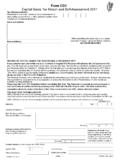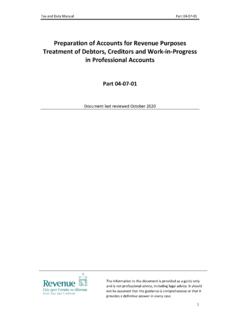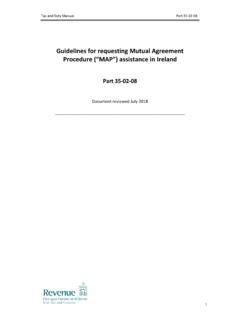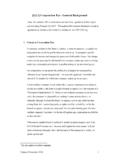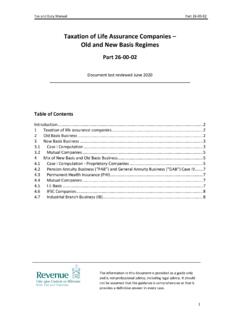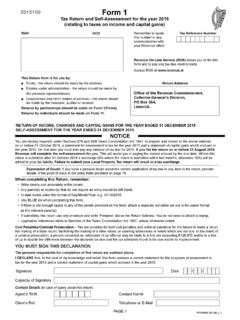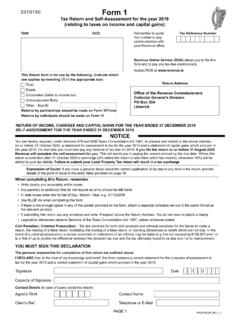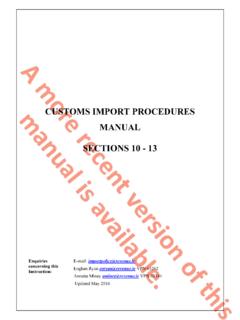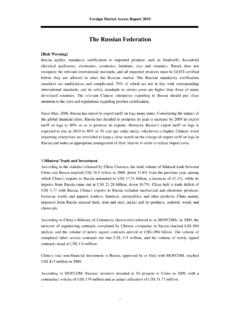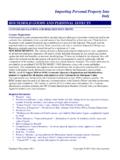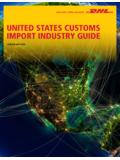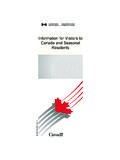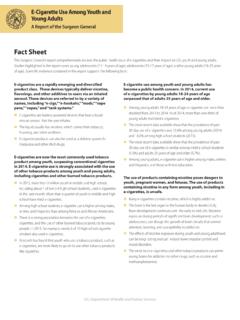Transcription of A Traders Guide to Customs Import Procedures
1 May 2018 A Guide to Customs Import Procedures 2 CONTENTS 1. Introduction .. 4 What is this Guide about? .. 4 What does importation mean? .. 4 Why is Revenue interested in imports? .. 4 What goods are prohibited or restricted? .. 4 2. Overview of importing .. 6 Pre-arrival of the goods in the EU .. 6 Where can you Import your goods? .. 6 What places are approved? .. 6 Goods arriving through another Member State .. 7 What must you do when the goods arrive? .. 7 What happens once goods are presented to Revenue? .. 7 What are Customs Procedures ? .. 7 Can you employ an agent to work on your behalf? .. 8 How are Customs Duties set? .. 8 3. Declaring Goods for Customs purposes .. 9 How do you make a declaration? .. 9 What are the main features of the electronic Customs declaration? .. 9 Commodity code .. 9 Customs procedure code .. 10 Valuation declaration forms (G563 or G563A) .. 10 Rates of Exchange .. 11 What charges may be payable? .. 11 How are these charges calculated?
2 11 Examples of how duties are calculated .. 13 How do you pay the relevant charges? .. 13 What documents should accompany your declaration? .. 13 Can you obtain relief from payment of duties? .. 14 4. Simplified Procedures .. 15 General .. 15 5. Electronic Customs .. 16 General .. 16 Automated Entry Processing (AEP) .. 16 Import Control System (ICS) .. 17 Arrivals system .. 17 Electronic Manifest System (EMS) .. 17 Economic Operators Registration and Identification System (EORI) .. 18 6. Authorised Economic Operator (AEO) .. 19 What does (AEO) status mean and how can it benefit me? .. 19 3 What are the benefits of AEO status? .. 19 Are there different types of AEO authorisation? .. 20 How do you apply for AEO status?.. 20 7. Special Procedures .. 21 What are special Procedures ? .. 21 End-use .. 21 What is End-use? .. 21 How can you get End-use relief?.. 21 How to apply for end-use and further information .. 21 Inward Processing .. 22 What is Inward Processing? .. 22 How can you get Inward Processing relief?
3 22 Applications and further information .. 23 Outward processing .. 23 What is outward processing? .. 23 How can you get outward processing relief?.. 23 Applications and further information .. 24 Customs warehousing .. 24 What is Customs warehousing? .. 24 How can you operate a Customs warehouse? .. 25 Applications for warehousing and further information .. 25 Temporary admission .. 26 What is temporary admission? .. 26 How can you apply for temporary admission? .. 27 Further information .. 27 8. Miscellaneous Issues .. 28 Preferential Trade Agreements .. 28 Origin Certification .. 29 Generalised System of Preferences (GSP) .. 30 Registered Exporters System (REX) .. 30 Tariff quotas .. 31 Returned goods relief .. 31 What is returned goods relief? .. 31 How can you get returned goods relief?.. 31 Your goods have been seized what can you do? .. 31 Can you appeal a decision made by Revenue? .. 32 Further information .. 33 4 1. Introduction What is this Guide about? This Guide is for anyone whether in business or not, who wishes to bring goods into Ireland from outside the European Union (EU).
4 At present there are 28 Member States of the EU as follows: Austria, Belgium, Bulgaria, Cyprus, Czech Republic, Denmark, Estonia, Finland, France, Germany, Greece, Hungary, Ireland, Italy, Latvia, Lithuania, Luxembourg, Malta, Netherlands, Poland, Portugal, Republic of Croatia, Romania, Slovakia, Slovenia, Spain, Sweden and the United Kingdom. The Guide will help you to understand the Procedures involved when importing goods and the Customs formalities involved. What does importation mean? In the context of this Guide , importation means bringing goods into Ireland from any country outside of the EU for personal or commercial reasons. Why is Revenue interested in imports? Revenue is responsible for controlling imports into Ireland for Customs purposes and on behalf of other government departments. All goods imported into Ireland must be declared to Revenue on arrival. Among other things, Customs officers make sure that any goods declared for Import are moving legally and are not prohibited or restricted.
5 What goods are prohibited or restricted? Certain goods such as drugs, indecent or obscene material, specific weapons and counterfeit goods are prohibited from being brought into the country under any circumstances. Their attempted importation will result in seizure. You can Import certain other goods with a licence issued by the appropriate authorities. For 5 example, meat or meat products require a licence from the Department of Agriculture Food and the Marine and endangered species require a licence from the National Parks and Wildlife Service. You will find a full list of prohibited or restricted items in Prohibitions and Restrictions on the Revenue website. 6 2. Overview of importing Pre-arrival of the goods in the EU The carrier of the goods must lodge an electronic safety and security declaration called an Entry Summary Declaration (ENS) in advance of the arrival of the goods. This entry must be lodged at the office of first entry of the goods in the EU. You can do this by using the Import Control System (ICS).
6 (See Part 5 of this Guide for further information on ICS.) Where can you Import your goods? You can only Import or land your goods at a place approved by Revenue and in the presence, or with the authority, of the proper Revenue official. Goods landed other than this are liable to forfeiture. All goods which arrive at an approved place must be presented to Revenue. What places are approved? The following places are approved in Ireland: for goods imported by sea, an approved sufferance wharf in practice, any of the main ports for goods imported by air, an approved Customs airport (the only approved Customs airports are Dublin, Cork and Shannon) for goods that are not cleared by Revenue at a port or airport, an approved premises such as a transit shed, container compound, a transit depot or a temporary storage premises. 7 Goods arriving through another Member State If your goods arrive in another EU Member State but you intend to clear them in Ireland for Customs purposes, they must travel under a transit procedure.
7 You will find further information in Transit on the Revenue website. Transit rules will apply to your goods until they reach an approved office of destination. What must you do when the goods arrive? Once your goods arrive at an approved place they must be presented to Revenue by the person who brought the goods into the State. Presented means informing Revenue, usually in the form of a manifest, that the goods have arrived and are available for Customs control. What happens once goods are presented to Revenue? Once the goods are presented to Revenue at the place of landing or are removed to an approved premises, they may be assigned to a Customs procedure or brought to a temporary storage facility (maximum duration 90 days). What are Customs Procedures ? The following are Customs Procedures : release for free circulation transit Customs warehousing temporary admission end-use inward processing outward processing export. 8 Can you employ an agent to work on your behalf?
8 You can appoint a representative to work on your behalf. The type of representation may be either direct or indirect. Direct representatives act in the name of and on behalf of another person. Indirect representatives act in their own name but on behalf of another person. How are Customs Duties set? The Customs Duty rates charged on goods imported from outside of the EU are set out by the EU Commission in a Regulation known as the Combined Nomenclature (CN). These duty rates are common across the 28 Member States of the EU. The CN is updated every year in order to take account of: changes in requirements relating to statistics and commercial policy to fulfil international commitments and to allow for technological and commercial developments. 9 3. Declaring Goods for Customs purposes How do you make a declaration? Goods imported into the EU must be declared to Revenue electronically through the Direct Trader Input (DTI) facility. This system allows importers or their agents to clear consignments at Import by lodging an electronic Customs declaration to Revenue.
9 Further information on this system is available in Direct Trader Input (DTI) on the Revenue website. What are the main features of the electronic Customs declaration? Two of the most important pieces of information required in the electronic Customs declaration are the: commodity code (also called tariff heading, tariff code, classification code or harmonisation (HS) code) and Customs procedure code. These pieces of information have a significant impact on the duty due and how the consignment will be treated. Commodity code The commodity code used for imports is a ten-digit number. This corresponds to a description of the goods being imported. Every product has a unique commodity code. This code determines the correct rate of duty. You will find information about commodity codes in TARIC on the EU commission website. TARIC is a database managed by the European Commission and used by all Member States. This database allows you to search for a commodity code by submitting a description or part description of the product in question.
10 You may also input a tariff code and find information on the duty rate, the product s description or any restrictions that may 10 apply to the product. Alternatively, you can contact our Classification, Origin and Valuation Unit. This unit will offer an opinion on the classification of your product. You can also apply for Binding Tariff Information (BTI) which is a tariff classification decision that is legally binding throughout the EU. Contact details for Classification, Origin and Valuation unit: telephone - +353 (0) 67 63370 or 1890 626 364 to Monday to Friday (except Public Holidays) Address - Office of the Revenue Commissioners, Government Offices, St. Conlon s Road, Nenagh, Co. Tipperary MyEnquiries. Customs procedure code The Customs procedure code describes the procedure or regime under which the goods are to be placed. It is required on all electronic Customs declarations. You will find a full list of procedure codes in AEP trader Guide - appendix 18 on the Revenue website.

